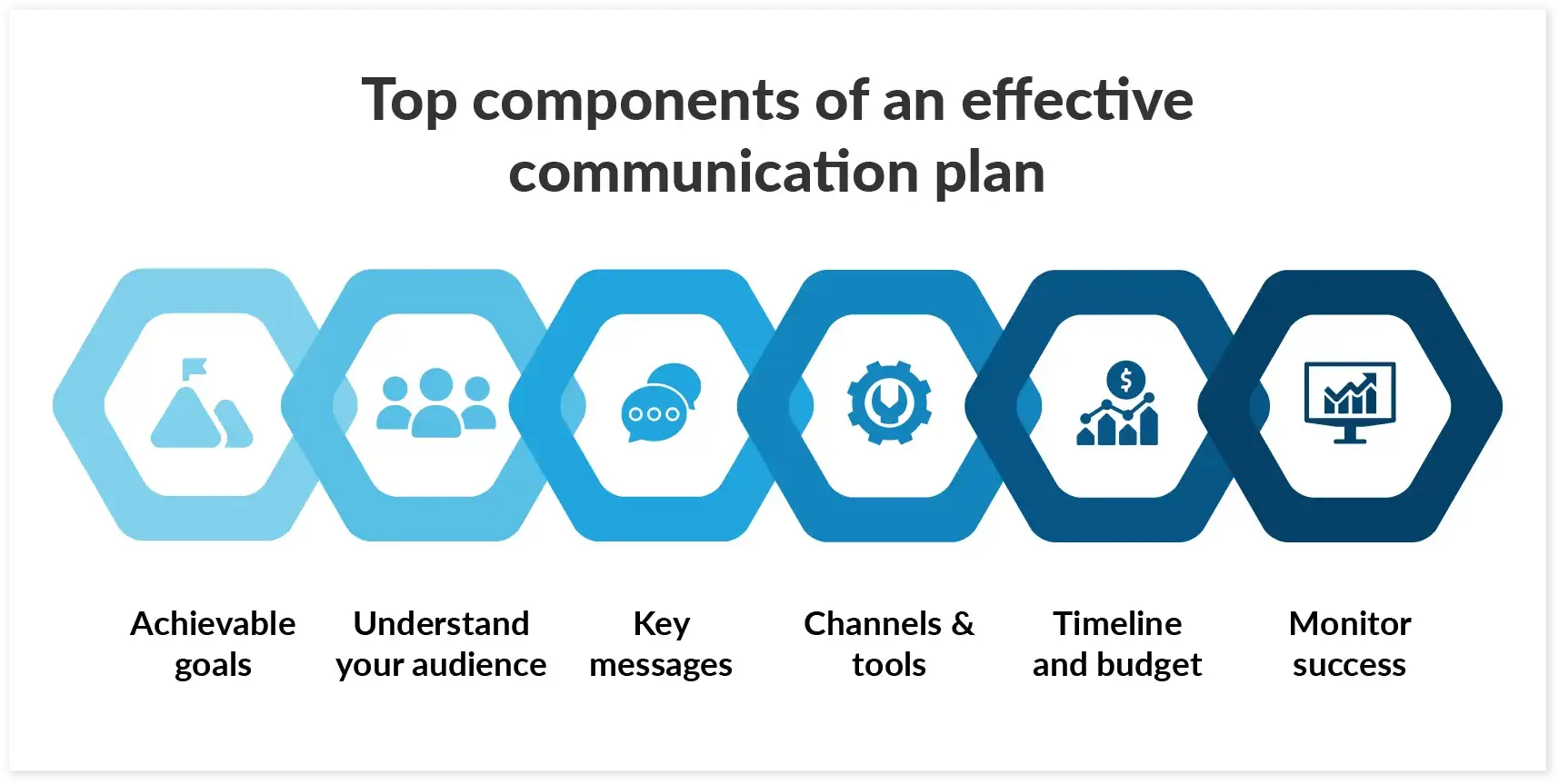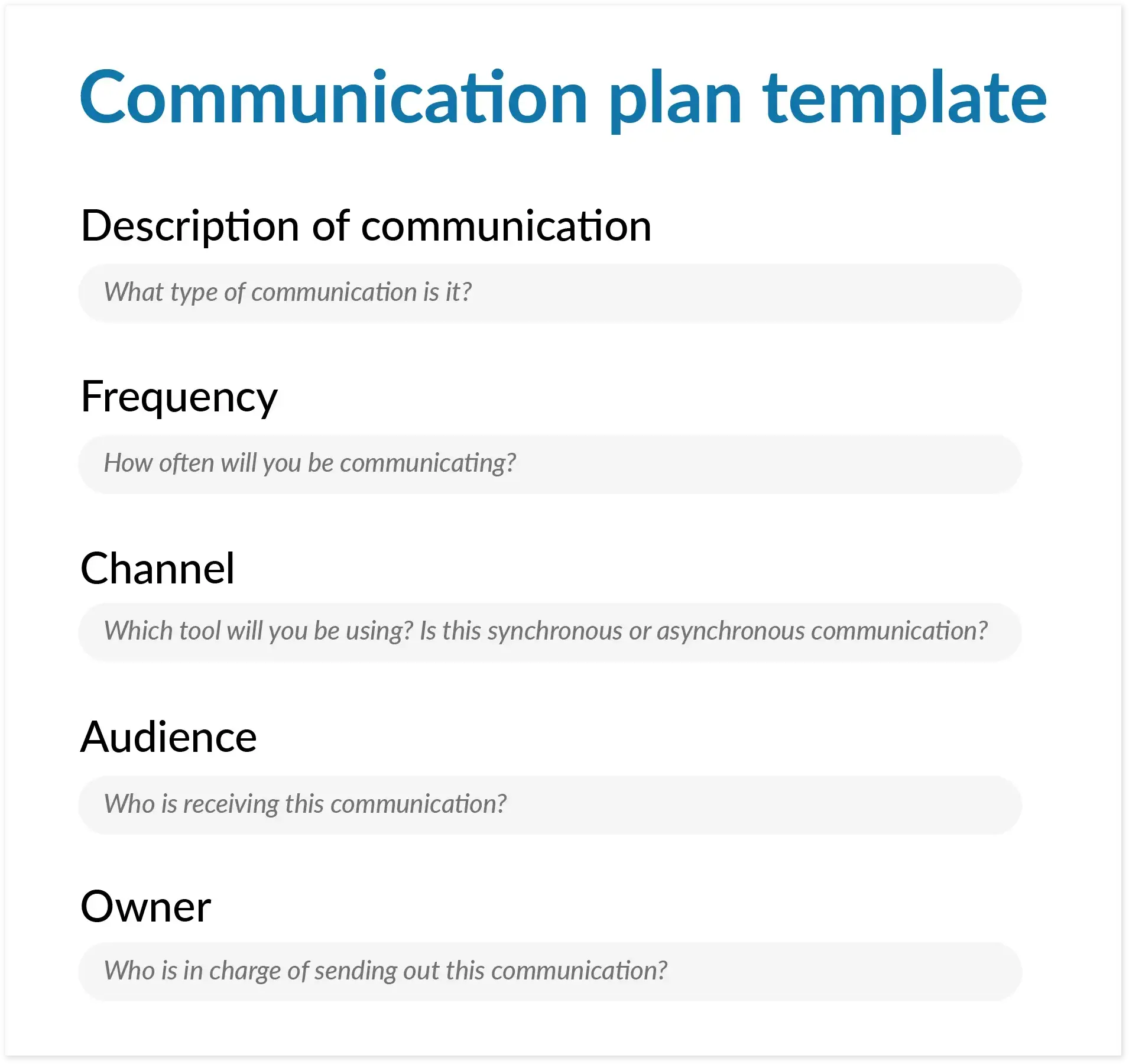9 steps to create an effective communication plan

We are in a hyper-connected world, and the success of any organization hinges on its ability to communicate effectively. From launching a new product to managing a crisis, how and what you communicate can make or break your company's reputation. That's where a well-crafted communication plan comes into play, serving as a lifeline that keeps your company’s message clear and consistent across all channels. Whether you're a startup or a seasoned enterprise, understanding the anatomy of a great communication plan is essential.
What is a communication plan?
A well-crafted project communication plan is your strategic blueprint, your director’s handbook. It tells you exactly what needs to be communicated, pinpointing the key messages that align with your project’s goals and objectives. It identifies your audience—whether they are team members, stakeholders, or executive stakeholders—that you need to reach, understand, and engage. And it doesn’t stop there. This plan also dictates the communication methods and channels through which your information will travel, be it through social media, press releases, internal newsletters, or community events.
Think of it as a compass guiding your organization through the vast ocean of communication. It ensures that whether you’re talking to a loyal customer, a curious prospect, or your own team members, your voice is consistent, clear, and compelling. With a project management communication plan in place, every department—from marketing to customer service—harmonizes their efforts, reinforcing the same story, the same values, and the same brand promise at every turn.
Without this cohesive strategy, mixed messages can create confusion, dilute your brand’s impact, and erode trust. But with a good communication plan, you create a symphony of words and actions that captivate your audience, build stronger relationships, and ultimately drive your company’s success. In essence, a communication plan is not just about what you say—it's about ensuring every interaction echoes your brand’s narrative, creating a seamless and engaging experience for everyone involved.
Top components of a great communication plan

Creating a standout communication plan involves a series of thoughtful steps, each crucial to ensuring your message hits the mark. First, set clear, achievable goals. Think about what you want to accomplish with your communication strategy. Do you aim to raise awareness, change perceptions, or drive action? These goals are your guiding star, directing the rest of your strategy and providing a benchmark to measure success. An effective communication plan helps you stay focused and aligned with these goals.
Next, understanding your audience is paramount. Imagine you're at a dinner party. You wouldn’t tell the same stories to a group of teenagers that you would to a board of directors, right? Knowing who your audience is, what they care about, and how they consume information is essential. This insight allows you to tailor your messages so they resonate deeply and elicit the desired responses. Identifying the type of communication that works best for different audience segments is crucial.
Crafting your key messages is another critical step. These are the core ideas you need to convey to influence and engage your audience. Your messages should be compelling, concise, and clear, providing a consistent narrative across all communication channels. Whether it's a press release, a social media post, or an internal memo, your key messages should reflect the essence of what you want to say and stay consistent throughout. This consistency is vital in an internal communication plan to ensure everyone is on the same page.
Channels and tools come next. In today's digital age, there are countless ways to communicate, from traditional media to social platforms and beyond. Choosing the right channels depends largely on where your audience spends their time and which formats they engage with most. Are they scrolling through Instagram, checking their email, or attending webinars? Meet them where they are. For a project manager, understanding these channels can help ensure that team members and stakeholders receive the information they need promptly.
A defined timeline and budget are also vital components. These elements ensure that your communications are not only strategic but also timely and financially sustainable. Imagine planning a big event without knowing the date or the cost—it would be chaos. Similarly, your communication plan needs a schedule and budget to keep everything on track.
Finally, monitoring the success of your communications through metrics and feedback mechanisms is crucial. This allows you to see what's working, what isn't, and make necessary adjustments. Think of it as checking your compass on a journey. You need to ensure you're on the right path and be ready to change course if needed to reach your destination. Metrics will help you identify areas for improvement and ensure your communication efforts are effective.
By focusing on these components—goals, audience, key messages, channels, timeline, budget, and metrics—you’ll create a communication plan that not only tells your story but also connects with your audience in meaningful ways.
How to write a communication plan
Creating a communication plan is more than just organizing messages; it's about crafting a story that will capture and inspire your audience. Let's break down the nine steps to build a communication plan that truly works:
Audit your current communication methods
Start by taking a good look at how you currently communicate. What methods are you using? Are they effective? This step is like cleaning out your closet—you need to know what you have before you can decide what you need. Review your guidelines, protocols, and previous communication strategies to identify what’s working and what’s not. Maybe you’ve been relying heavily on email, but your audience prefers social media updates. Or perhaps your internal memos are too lengthy and losing your team’s interest. Understanding your current landscape helps you build a stronger foundation for future communications.
Set clear objectives
Now that you’ve reviewed your existing methods, it’s time to set your goals. What do you want to achieve with your new communication plan? Maybe you’re aiming to increase brand awareness, drive sales, or improve customer satisfaction. Setting clear, specific objectives based on your findings will guide your entire strategy and help you stay focused. Think of this step as setting the destination for a road trip—without knowing where you’re going, you’ll just be driving aimlessly. Clear objectives give you direction and purpose, ensuring every message you craft serves a greater goal.
Define your audience
Who needs to hear your message? Understanding your audience is like knowing your dance partners—you need to move in sync. Segment your audience to ensure that your communication is relevant and tailored to their needs and preferences. This might mean crafting different messages for different groups to maximize engagement. Picture yourself at a party: you wouldn’t tell the same story to your grandmother as you would to your college buddy. By knowing who your audience is, you can tailor your approach, ensuring your messages resonate and elicit the desired responses.
Draft your plan
Start drafting your communication plan. Think of this as your rough sketch. Outline your key messages, the channels you’ll use, and the timeline for delivery. This draft doesn’t have to be perfect; it’s just a starting point that you can refine as you go along. It’s like creating a blueprint for a house—you need to have a general idea of the structure before you start building. This initial draft helps you visualize the flow of your communication and identify any gaps or areas that need more attention.
Gather feedback
Before finalizing anything, get feedback. Share your draft with a small group of trusted colleagues or stakeholders. This step is crucial because it allows you to see your plan from different perspectives. Constructive criticism will help you improve your communication plan and make it more effective. Think of this as trying out a new recipe—you want to know what your guests think before you serve it at a big dinner party. Feedback helps you fine-tune your plan, making sure it’s as effective and impactful as possible.
Choose your channels
Choosing the right channels is vital. In today’s digital age, you have many options, from social media to email newsletters to traditional media outlets. Think about where your audience spends their time and how they prefer to receive information. This will help you select the most effective channels for your message. It’s like deciding whether to send a letter by email, snail mail, or text message—each channel has its strengths and is suitable for different types of communication. By picking the right channels, you ensure your message gets heard.
Schedule your communications
Timing is everything. Create a detailed schedule outlining when each piece of communication will go out. Align your timeline with key events, product launches, or seasonal activities to maximize impact. A well-planned schedule ensures that your messages are timely and relevant. Think of this as planning a garden—you need to plant your seeds at the right time to ensure they grow and flourish. A clear schedule helps you stay organized and ensures your communications are well-timed and effective.
Assign responsibilities
Assign clear roles and responsibilities. Who is responsible for crafting the messages? Who will distribute them? Knowing who is doing what ensures accountability and helps keep everything on track. This step is like assembling your team for a mission—everyone needs to know their role. By assigning responsibilities, you ensure that each part of your communication plan is executed smoothly and efficiently, without any confusion or overlap.
Evaluate and adjust
After rolling out your communication plan, it’s time to evaluate its performance. Use metrics to measure success and gather feedback from your audience. This review process is like a post-game analysis—it helps you understand what worked, what didn’t, and how you can improve next time. Testing different approaches and analyzing the results will provide valuable insights for future communication efforts. It’s like adjusting your course based on the feedback from your GPS—you need to be ready to change direction if necessary to reach your destination effectively.
By following these steps, you’ll create a communication plan that not only tells your story but also connects with your audience in meaningful ways. It’s all about creating a seamless and engaging experience that drives your project forward.
Why is communication planning important?
Effective communication is the backbone of any successful organization. A well-thought-out communication plan ensures that your messages are clear, consistent, and purposeful. Here’s why a communication plan is crucial:
- Builds and Maintains Trust: Reliable and coherent information helps build and maintain trust with your target audience, whether they’re employees, customers, or project stakeholders.
- Prevents Misunderstandings: When everyone is on the same page, it prevents misunderstandings and mistakes. A communication plan can help identify the information you need to share and determines who will be receiving and responsible for delivering that information.
- Aligns with Business Goals: A strategy plan aligns your communication with your business goals, making your efforts more strategic and impactful. This plan is vital for ensuring that your communication efforts support your overall objectives.
- Keeps Teams Informed and Engaged: It keeps your team informed, engaged, and moving together towards common objectives. A communication plan will help manage the frequency of communication and ensure everyone stays up-to-date.
- Supports Crisis Management: Having a crisis communication plan is also critical. It helps manage communication during crises, ensuring that confidential or sensitive information is communicated effectively to key stakeholders.
- Facilitates Communication and Collaboration: A good communication plan enhances communication and collaboration by defining roles and responsibilities and assigning tasks to team members. It helps stakeholders get on the same page, ensuring smooth and efficient project management.
Communication plan template

Present a comprehensive communication plan with Prezent
Structuring Your Communication Plan
Prezent's Story Builder helps you craft a clear and engaging narrative for your communication plan. This ensures your message is well-organized and easy to follow, making it more effective in conveying your strategy to stakeholders.
Saving Time and Ensuring Consistency
With the Auto Generator, you can quickly create personalized, on-brand presentations by inputting a few prompts. The Template Converter ensures that your slides remain consistent with your brand guidelines, enhancing the professionalism of your communication plan.
Facilitating Team Collaboration
The Prezentation Library feature allows you to share your presentation with team members, gather feedback, and keep all documents organized. This is crucial for ensuring that everyone involved in the project is aligned and informed.
Enhancing Engagement
Prezent offers a variety of multimedia options such as charts, infographics, and videos to make your communication plan more engaging. These elements help capture your audience’s attention and make complex information easier to understand.

To experience the full benefits of Prezent.ai for your communication plan, sign up for a free trial or schedule an expert demo to see how the platform can meet your needs. For more templates, explore Prezent's presentation templates.



.avif)








